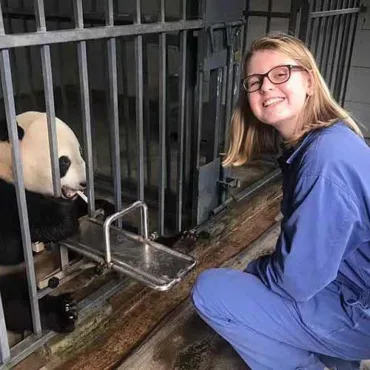When people think of Chengdu pandas, often the first thought that comes to mind is the Chengdu Research Base of Giant Panda Breeding.
As perhaps the most accessible of all the places where Chengdu pandas can be seen up close, the Chengdu Research Base of Giant Panda Breeding is located just 10 kilometers from the city center. By road, it takes roughly 40 minutes to reach the center, however you can use this valuable travel time to brush up on all the essential Chengdu panda facts (like the ones we share in this article!).
What makes Chengdu pandas so special?

Chengdu and pandas just go together, right? A bit like Suzhou and silk, or Beijing and duck, the two go hand in hand. And while giant pandas are incredibly cute – you’ll discover this when you arrive at the Chengdu Research Base of Giant Panda Breeding – there is a serious side to the preservation, care, and nurturing of these beautiful animals.
As the national treasure of China, pandas are considered to be at risk, although the World Wildlife Fund (WWF) has removed giant pandas from its list of critically endangered species.
Sadly, there are just 1,800 pandas still living in the wild, and around 300 live in other locations around the world. Of the total number of pandas in China, approximately 85 percent can be found in Sichuan Province – that makes it the home of pandas – hence the name ‘Chengdu pandas’.
What do pandas eat?

No doubt you’ve seen the iconic image of pandas munching on bamboo, and it’s with good reason. Pandas eat bamboo! In fact, about 99 percent of their diet is bamboo, and when you see how much pandas eat at the Chengdu Research Base of Giant Panda Breeding, you will realize that’s a lot of bamboos.
Each day, an adult panda eats between 23 and 40 kilograms of bamboo shoots, or 10 to 18 kilograms of bamboo leaves, or 17 kilograms of bamboo stems. And although there are over 500 different types of bamboo in China, pandas are fussy eaters. They will only eat 60 of these, and they prefer bamboo that is grown at altitude. Yes, a giant panda’s bamboo must come from 1,800 to 2,500 meters above sea level.
How did the Chengdu Research Base of Giant Panda Breeding come about?

What’s important to understand about bamboo is that it’s not a perennial, that is, it doesn’t flower annually. In fact, a flowering cycle may only occur every 40 to 50 years, and bamboo only flowers once in its lifetime, after which it produces seeds and dies.
It is this curious fact which contributed to the establishment of the Chengdu Research Base of Giant Panda Breeding in the 1980’s. During this period there was a mass flowering of bamboo, which resulted in wild giant pandas going hungry, and even fighting one another over the available food. A catastrophic event, this situation resulted in an estimated 200 giant pandas dying.
Recognizing how serious this was for the panda population, scientists rescued six animals from the wild, keeping them at the Chengdu zoo for research. In 1987, the Chengdu Research Base of Giant Panda Breeding was set up as a non-profit breeding facility for giant pandas. The center opened to the public almost ten years later.
The 100 hectare base covers a sprawling area, which is beautifully landscaped with bamboo (naturally!). Within this idyllic panda heaven, there are wide pathways that wind around the park, allowing ample space for visitors to view the pandas in a natural environment. The research center caters to the pandas’ every need with a delivery room, nursery rooms, kindergarten, feeding area, panda hospital and scientific discovery centre.
Since opening, the center continues to perform significant research work that supports the continued survival of giant pandas, an achievement which is recognizable in growth of the panda population from a modest 6 animals to nearly 200 giant pandas of all ages.
How to make the most of your visit to the Chengdu Research Base of Giant Panda Breeding
Check out these handy tips for transforming your trip to the panda base into a beautiful travel memory.
What’s the best time to visit?
On any given day, the base is popular, which is why we recommend arriving early, at opening time preferably, because although the center is huge, it is popular and becomes very busy, very quickly. This can make it difficult to get unobstructed viewing of these gorgeous creatures, and you definitely don’t want to miss the multiple photo opportunities that will arise at every enclosure. Another very good reason for arriving early is that feeding time is at 8.30am. Watching the giant pandas eat their bamboo with a Kung Fu panda-like relish is a sight to behold, and is hugely entertaining.
What animals are at the base?

Expect to see giant pandas of all ages and sizes, including adults, teens, and cubs of course, however other wildlife can be found at the base too. A large lake is populated by beautiful swans, red pandas can be seen making their way through trees, and there is a healthy population of beautiful peacocks that wander around the base.
What is the best way to get around the base?
For the best views of giant pandas in their enclosures, go on foot, however those who require accessibility support can hire a buggy to make their way around the base. If you plan taking a guided tour, be sure to speak with your guide and make arrangements in advance of arrival. Buggy hire is also a good idea if you are short on time, as it will take you to the panda kindergarten and drive you on to subsequent enclosures without having to navigate the crowds on foot.
Another factor to consider is whether you’d love to see the baby pandas. If your answer is a definitive yes, best to hold off your visit until a couple of months after July. Why? Well, pandas have just one mating season that occurs in spring every year. Mums deliver their tiny newborns around 100 days after July, so leaving your visit until then is highly recommended.
Can I feed the giant pandas?

There are strict guidelines about feeding pandas at the base, and the short answer to this question is no, there is no panda feeding at the base. If this is on your bucket list, it’s best to book a visit to the Dujiangyan Base, where you can enjoy the experience of working as a panda keeper for the day. Guidelines around feeding are strict because the wrong foods can cause infection in pandas, and this can rapidly spread through the population.
How long do I need for my visit?
Allowing half a day for your visit is a reasonable amount of time to visit all enclosures. If your itinerary is more relaxed, consider visiting the Dujiangyan Base, keeping in mind this is where you can soak up a full panda volunteer experience.
| Entry Prices | |
|---|---|
| Adults | ¥55 ¥10 buggy service |
| Children (6-18 years old) | ¥27 |
| Children (under 6 years old and under 130cm) | free |
| Food | Yes | Restaurants, cafes, gift shops, and panda ‘post office’ |
| Transport | Yes | Bus, subway, and taxi |
| Tours | Yes | Fully guided including transport to the base |
| Family friendly | Yes | |
| Close to city | Yes | 10 kilometers (40 minute drive) |
| Opening hours | Monday – Sunday 7:30 – 18:00 |
If you’d love to see the world’s largest collection of giant pandas up close, a visit to the Chengdu Research Base of Giant Panda Breeding offers a unique opportunity to understand these creatures better. Whether you choose to travel independently or on a guided China tour, we can assist with bookings and travel arrangements. We are travelers too and know what it takes to create beautiful travel memories – and we’d love to share our experience with you. Discover real China with people who really care. Contact us to learn more about meeting the world’s cutest bears.




 Please Use China Tours, They Deserve It!
Please Use China Tours, They Deserve It!





